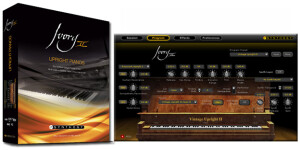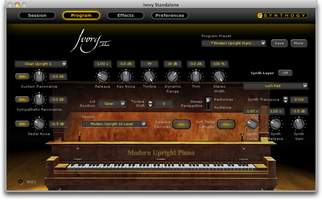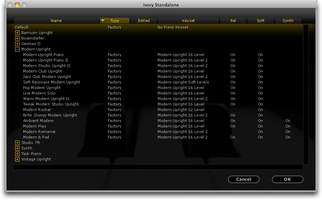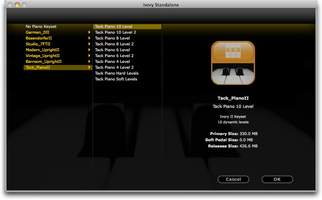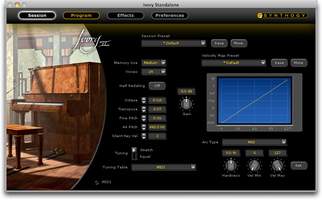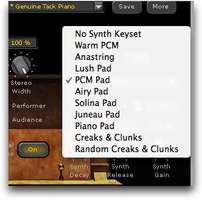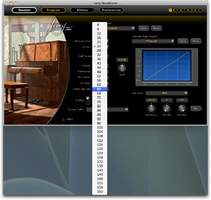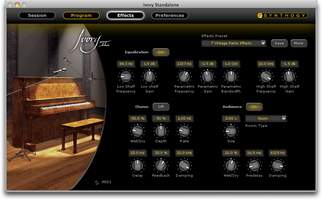After Grand Pianos, it's the turn of the Upright Pianos bank to be ported to Synthogy's new audio engine. Let's give it a try.
A Snap Shot: Mini-Review
Old Timer…
Chronologically, the first instrument is the genuine Tack piano. Synthogy states that this piano was manufactured in the early 1900's, it is not perfectly tuned and has metal tacks inserted into its hammer felts.
Certainly, this piano is a very good solution for silent movies, like in the following excerpt of “Mysterious – Burglar Music” from Sam Fox Moving Picture Music, Vol 1 of J.S. Zamecnik (public domain):

Or for blues, dance hall and boogie ambiances (song: Claude Bolling’s “Triplets Bass Boogie”):

Among all four pianos, this one provides the least nuances but still offers a nice presence:

Pretty high dynamic variations (you can adjust the response curve of the keyboard and the dynamic range):

We also appreciate the good velocity switches:

Let’s now listen to the resonance with muted strings:

The instrument gives also good results for soft parts, even though this piano is not conceived for such applications:

The piano can even be used for classical music (we went for a romantic example):

Finally, we end with the tribute already used in previous product reviews using two instances of the piano:

Barroom Piano…
Let’s continue with a piano that comes directly from the smoky atmosphere of the famous Cheers bar in Boston. The piano itself is almost a museum piece from 1915 — 19 years after the Packard Piano & Organ Company included pianos in its product catalog. The pianos of this manufacturer were famous for their high manufacturing quality and their premium woods.
This piano gives also very good results for silent movies (“Mysterious – Burglar Music” once again):

And also for boogie:

In the following example, you’ll notice that the attack sounds a bit metallic:

The number of layers allows more dynamic variations:

This is clearly audible in the velocity switches. The brutal increase of mechanical noise at higher velocity levels is more than reproachable:

On the following example you can hear the resonance with muted strings:

At low velocity levels, the piano produces a very “misty” and “smooth” sound that gives very good results for nostalgic or soft ambiances:

Its use on a piece of Rimsky-Korsakov is also interesting:

And we end with the tune using two pianos:

The most attentive of you certainly noticed that some examples include crackles, seat noise and other unwanted noises. They belong to the Cleaks and Crunks and Random Creaks and Clunks layers that can be activated in the Synth Layer area of each piano (also for the Grand. A noisy Bösendorfer is essential…). Every single one of the 88 notes of the keyboard has a full set of extras to add authenticity to the sound — in fact, it’s more like hyperrealism, in other words, a fake reality… Some noises cover only one key while others have been resampled for several notes:

You can also use these samples as pretty interesting rhythmic elements:

Almost Twin, but Different…
Here comes another old-timer: the A.M. Hume piano sampled by Synthogy was built in 1914. This piano was manufactured by M. Steinert & Sons, in one of their two factories in Leominster (Massachusetts). Besides manufacturing pianos, Steinert was also an authorized Steinways & Sons dealer and, to avoid any confusion, sold his instruments under the brand names Jewett, Curtis, Woodbury, Berkshire and A.M. Hume (the name of the chairman at that time, Archibald Hume). The name M. Steinert & Sons was used again from 1916 onwards. These instruments had a very good reputation. The piano sampled by Synthogy is 100% original.
Let’s start with “Mysterious – Burglar Music”:

The boogie shows a tight, well-balanced sound with a strong attack and enough resonance, without being too intrusive:

The strong attack allows the sound to be always well-defined, even during loud passages:

Given the number of layers, the dynamic range is wider:

This is confirmed by the velocity switches. However, we found a minor flaw: the mechanical noises are too similar with high-velocity levels…

Resonance with muted strings:

The very well-balanced tone makes it a very intimate piano when played in the mid velocity range:

It sounds also very good with the romantic piece:

And we end with the tune using two pianos:

Modern…
Finally, the modern piano of the sound library is a Yamaha U5 (no manufacturing date is given, but I believe the production was discontinued in 2006). Considered an up-market product in Yamaha’s range, the piano was carefully tuned and prepared before sampling.
“Mysterious – Burglar Music” does not sound as authentic as with the older pianos but serves to show the very wide dynamic range of the instrument:

The boogie tune discovers the typical Yamaha sound (either you like it or not): well balanced and with that special Yamaha attack. In real life, to achieve this sound you need strong fingers and a wrist of steel.

The impact of this piano if very particular:

Thanks to the numerous layers, the nuance range is very wide, the sound stays always well-defined and bright with the high-quality resonance typical to all higher-end pianos of the manufacturer:

Velocity switches show a nice linearity:

On the following example you can hear the resonance with muted strings:

The well-balanced sound works pretty good on the following example, even if I prefer the Vintage in this particular situation because the Modern is a bit too bright:

On Rimsky-Korsakov’s piece, it recalls a 1/4 (or even 1/2) grand piano, with a little help from the ambiance:

On the song with two pianos, the brightness helps the melody cut through:

Conclusion
A brief reminder before wrapping up: each of the 88 notes uses its own samples with up to 16 velocity layers. The samples are not looped so you get nice-sounding resonances (you “hear” the wood).
It’s difficult to find more cons than the ones already mentioned. Once again, Synthogy succeeds in offering the most comprehensive upright pianos bank in the market. The price makes it quite affordable, considering the rich and detailed sound of the samples. Needless to say, this product is very specialized and there are other options out there.
But for professional musicians and producers who look for exceptional pianos requiring almost no setup time (the instruments are almost ready to play and you’ll just have to adjust the sensitivity to your master keyboard), that sound great across the whole keyboard, and are easy to add to a mix, there won’t be much to think about.


